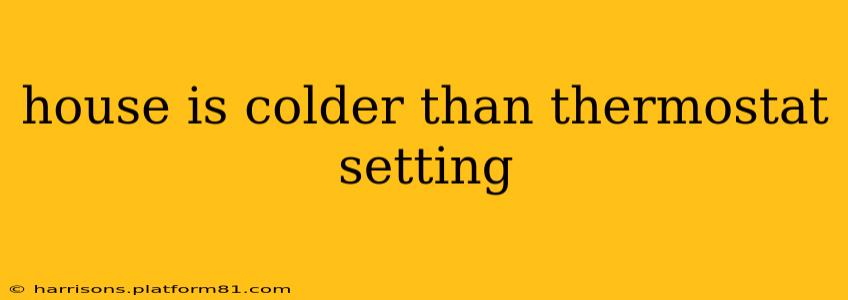Is your house consistently colder than what your thermostat is set to? This frustrating problem can stem from various sources, ranging from simple fixes to more complex issues requiring professional attention. Let's delve into the common culprits and how to tackle them. This guide will help you diagnose the problem and get your home to the comfortable temperature you desire.
Why is My House Colder Than the Thermostat Setting?
This is a common question, and the answer often isn't straightforward. Several factors can contribute to this temperature discrepancy. Let's explore some of the most frequent causes:
1. Incorrect Thermostat Calibration or Placement:
-
Calibration Issues: Your thermostat might be miscalibrated, displaying an inaccurate temperature reading. A simple solution is to check it against a reliable thermometer placed in the same location. If there's a significant difference, you might need to recalibrate your thermostat (refer to your thermostat's manual for instructions).
-
Poor Placement: The location of your thermostat significantly impacts its accuracy. Avoid placing it in direct sunlight, near drafts, or close to heat-generating appliances (like ovens or fireplaces). These factors can skew its readings and lead to inaccurate temperature control. Ideally, it should be mounted on an interior wall, away from these influences, at about 5 feet above the floor.
2. Inadequate Insulation and Air Sealing:
-
Insufficient Insulation: Poor insulation in your walls, attic, and floors allows heat to escape rapidly, making your home feel colder than the thermostat setting indicates. This is especially true in older homes. Consider upgrading your insulation to improve energy efficiency and maintain a consistent temperature.
-
Air Leaks: Drafty windows, doors, and gaps in your walls allow cold air to seep in, negating the heating system's efforts. Caulk, weatherstripping, and sealing air leaks are crucial for maintaining a comfortable indoor temperature.
3. HVAC System Malfunctions:
-
Insufficient Heating Capacity: Your heating system might not be powerful enough to heat your home effectively, especially if you’ve recently expanded your living space or made significant changes to your home's insulation. This could require upgrading your furnace or heat pump.
-
Dirty Air Filters: A clogged air filter restricts airflow, reducing the efficiency of your heating system. Regularly changing your air filter (typically every 1-3 months) is crucial for optimal performance.
-
Faulty Furnace or Heat Pump: A malfunctioning furnace or heat pump can fail to provide adequate heat. Listen for unusual noises, check for error codes, or contact an HVAC technician if you suspect a problem.
4. Thermostat Settings and System Modes:
-
Incorrect Mode: Ensure your thermostat is set to "Heat" mode and not accidentally switched to "Cool" or "Auto."
-
Programming Errors: If you use a programmable thermostat, check the programming schedule to make sure it's aligned with your desired temperature settings.
5. High Heat Loss Through Windows:
- Single-Pane Windows: Older homes often have single-pane windows that are significant contributors to heat loss. Consider replacing them with energy-efficient double- or triple-pane windows for better insulation.
6. Ductwork Issues:
- Leaky Ducts: Leaks in your ductwork can cause significant heat loss before it even reaches your living spaces. Professional duct sealing can significantly improve efficiency.
What Should I Do if My House is Still Too Cold?
If you've addressed the common issues listed above and your house remains colder than the thermostat setting, it's time to consult a professional HVAC technician. They possess the expertise to diagnose more complex problems and provide appropriate solutions.
This comprehensive guide should help you tackle the mystery of why your house is colder than your thermostat setting. By systematically checking these points, you can identify the root cause and restore comfort to your home. Remember, addressing these issues not only improves comfort but also contributes to energy savings and a more efficient home environment.
